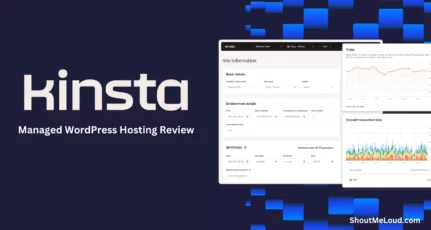Trying to decide between SiteGround vs Bluehost to host your website?
SiteGround and Bluehost are two of the most popular web hosts for any type of website, and both also offer lots of useful features for WordPress users. Because you’ll see so many people recommending both hosts, it can be hard to know which one is right for you.

In this post, I’m going to help you decide between Bluehost vs SiteGround. This isn’t about picking a single “winner”. Instead, I’m going to highlight the key differences and make some recommendations so that you can pick the option that best fits your needs and budget.
I’ll start by comparing them in three keys areas:
- Pricing
- Performance
- User-friendliness
Then, at the end, I’ll make some recommendations on when you should pick SiteGround and when you should pick Bluehost.
SiteGround vs Bluehost Pricing
In general, when it comes to pricing and resources, Bluehost is more affordable than SiteGround. This is true for both the promotional prices (what you pay for your first billing cycle) and the regular prices (what you’ll pay when you need to renew).
Here are Bluehost’s prices:

And here are SiteGround’s:

Beyond looking at the pricing charts, there are a few other important things to consider here:
- Resources
- Billing terms
- Free domain name
Winner: Bluehost
Bluehost Gives You Unlimited Resources
Another thing that makes Bluehost cheaper is the resources that you get with your plan. With the exception of the cheapest Basic plan, Bluehost gives you:
- Unlimited websites
- Unmetered storage
- Unmetered bandwidth
SiteGround does give you unlimited websites (excluding the StartUp plan) and unmetered bandwidth. However, they impose strict storage limits. For example, even the expensive GoGeek plan only gets 40 GB, while Bluehost still gives you 50 GB on the cheap Basic plan (and unlimited storage on all the others).
Additionally, while SiteGround does offer unmetered bandwidth, they do advertise a suggested visit limit. This limit isn’t a hard cap – it’s just an estimate of how many visitors you can have before SiteGround’s other limits (like CPU seconds) kick in. If you want to see the technical limitations of SiteGround’s plans, you can:
- Go to this page
- Scroll down to the bottom
- Hover over the links in the Server Resources section

I also wrote a post explaining the limitations of SiteGround shared hosting.
Note that, while Bluehost doesn’t meter any of your resources, they will still enforce fair use policies. So if they feel that you’re abusing the limits, they might still restrict your account:

Winner: Bluehost
SiteGround Only Lets You Get the Full Promo Prices for Only One Year
Because both Bluehost and SiteGround’s promotional prices offer such a big discount, it’s usually a good idea to pay for as many years as possible upfront. For example, if you pay for three years upfront, you can lock in the cheap prices for all three years.
You used to be able to do this at both Bluehost and SiteGround. However, as of 2020, SiteGround only gives you the full promotional discount on your first year. If you try to pay for two or three years upfront, you will still get a small discount, but not the full advertised promotional price.
For example, let’s say you want the SiteGround StartUp plan, which is advertised as having a promotional price of $6.99 per month and a regular price of $14.99 per month. If you sign up for a year, you’ll pay that $6.99. However, the prices for two and three-year plans are slightly higher:
- Two years – $9.99 per month
- Three years – $10.49 per month
So while you still get a discount, the deal isn’t quite as good.
With Bluehost, it works in the opposite direction. The longer the period you sign up for, the bigger the discount you’ll get.
For example, let’s say you want the Bluehost Plus plan, which is advertised as having a promotional price of $5.45 per month and a regular price of $10.99 per month. If you want to get that full promotional price, you’ll need to pay for three years upfront. If you pay for a shorter period, the monthly price will be higher:
- One year – $7.45 per month
- Two years – $6.95 per month
- Three years – $5.45 per month
Winner: Bluehost
Free Domain Name
Finally, Bluehost gives you a free domain name for your first year, while SiteGround doesn’t. Additionally, if you want to purchase your domain via SiteGround, they’ll charge you $15.95 for a .com domain, which is pretty expensive. Bluehost will also charge you $15.99 to renew your domain name after the first year, though, so Bluehost’s prices are also fairly high.
If you want to save some money, you can use a third-party registrar like Namecheap or Google Domains, which charge more like $10-$12 for a .com domain name.
Winner: Bluehost
SiteGround vs Bluehost Performance
While Bluehost wins in terms of pricing and resources, SiteGround is ahead when it comes to performance.
Hosting Architecture
One of the things that explain why SiteGround is more expensive is that SiteGround has been investing a lot of money into its infrastructure, which means better performance for SiteGround customers.
For example, SiteGround recently moved all of its hosting plans, even the shared ones, to Google Cloud hosting, which lets you benefit from Google’s network.
SiteGround also uses a blend of Apache (as the webserver) and Nginx (as a reverse proxy), which lets them offer server-level page caching (but only on the GrowBig and GoGeek plans). Server-level caching not only eliminates the need for a separate caching plugin, but it also performs a little better than caching plugins because your server can completely skip WordPress when loading content from the cache.
I know that’s a little technical, but the only thing you really need to understand is that this makes your site load a lot faster.
SiteGround also offers all of its customers a free plugin called SG Optimizer. SG Optimizer helps you easily implement all the most important WordPress performance best practices including minification, image optimization, Gzip compression, browser caching, and more.

SG Optimizer is every bit as good as the WP-Rocket plugin and SiteGround customers get it for free.
Finally, on the GoGeek plan, SiteGround recently added its own Ultrafast PHP setup, which can further boost performance.
Bluehost doesn’t completely ignore performance – you do get some features like built-in caching. But in general, SiteGround’s hosting architecture is more optimized than Bluehost’s.
Winner: SiteGround
Performance comparison test:
In my performance comparison test, SiteGround is definitely a winner. However, the price difference between two does not really justify this win, and I was expecting a much better result from SiteGround.
For this test, I have used Genesis theme + Cloudflare setup on a live site with same set of plugins. Let’s look at the results from the different tests:
TTFB Test
Bluehost:

SiteGround:

Winner: SiteGround
Even in the site response time, and load time SiteGround was a clear winner.
Data Center Locations
Another important part of WordPress performance is data center locations. The physical distance between your host’s data center and your visitors will play a big role in your site’s page load times. You can reduce this impact by using a content delivery network (CDN). However, you still want to always choose a data center that’s as close as possible to your target audience.
Another aspect that doesn’t get as much focus is backend dashboard load times. If you’re further away from your site’s data center, your WordPress dashboard will also load slower when you’re working on your site, which can be frustrating.
Here, SiteGround offers a lot more options. SiteGround gives you your choice of six data centers on four continents:
- North America – Council Bluffs, Iowa (USA)
- Europe – London (UK), Eemshaven (Netherlands), Frankfurt (Germany)
- Asia – Singapore
- Australia – Sydney
When you sign up, you can choose the data center that works best for you.
While Bluehost does have multiple data centers, they don’t let you choose. They also make it very hard to even find out which data centers they offer because they don’t list them on their website.
Instead, the data center that your site gets depends on which Bluehost service you sign up with. For example, if you sign up at the North American Bluehost site, your site’s server will be in Utah, USA. But if you sign up at the Indian Bluehost site, your site’s server will be in Mumbai, India.
In total, Bluehost has data centers in the following locations:
- North America – Utah, USA
- Europe – London, UK
- Asia – Mumbai (India), Hong Kong (China), Shanghai (China)
But again, make sure you sign up via the local Bluehost website for your region (or the region that you want to target) because you cannot choose your own data center like you can with SiteGround.
Winner: SiteGround
SiteGround vs Bluehost Dashboard/User-Friendliness
Bluehost and SiteGround are both very user-friendly hosts. In this section, I’ll go through their hosting dashboards and some key features.
Hosting Dashboard
Both SiteGround and Bluehost offer custom hosting dashboards to make it easier to manage your site.
As of 2020, SiteGround has completely moved away from cPanel to its own Site Tools dashboard. The Site Tools dashboard makes it easy to install WordPress and perform other key actions to manage your site.
Bluehost, on the other hand, uses a hybrid combination of its own custom dashboard, while still giving you access to cPanel if you want it. This combination is nice to have – beginners can perform the most important actions from Bluehost’s custom dashboards, while more advanced users can still access the full cPanel dashboard if needed.
Winner: Tie
Features
Both hosts also give you convenient features to help you manage your site.
With either host, you’ll get:
- Automatic WordPress updates
- Free one-click SSL certificates
- Free email hosting
- Staging sites
One important area where SiteGround wins out is backups. On all plans, SiteGround automatically backs up your site every day and stores 30 days of backups. Bluehost, however, only offers automatic backups on the most expensive Choice Plus plan.
However, keep in mind that SiteGround stores the backups on your site’s server, so you’ll want to periodically download them to your local computer to eliminate a single point of failure.
SiteGround vs Bluehost: Which Should You Use?
SiteGround and Bluehost are both popular hosts for a reason. That is, they each have their strengths and weaknesses and there’s not one “better” host for every single person.
Use Bluehost If…
In general, Bluehost is good for a beginner looking to get started for cheap. Bluehost’s pricing is about as cheap as possible, and you also get a free domain name for your first year which brings the cost down even further.
Additionally, Bluehost does a great job of making it simple and easy to launch a site. While SiteGround is also pretty easy to use, Bluehost’s onboarding wizard is one of the best and makes it really easy for a newbie to get up and running.
Use SiteGround If…
On the other hand, SiteGround is good for people who want to level up their hosting to get better performance. With its new prices, SiteGround is definitely more expensive than Bluehost – there’s no way to avoid that.
However, the upside is that you get better resources and useful tools for WordPress performance. For example, SiteGround uses Google Cloud infrastructure on all its plans now. On the GrowBig and GoGeek plans, they even implement server-level caching which offers excellent performance and means you don’t need a caching plugin.
SiteGround customers also get access to the free SG Optimizer plugin, which can rival premium performance plugins like WP Rocket in its feature set.
However, in order to get that improved performance, you’re going to pay a little more and you’ll also have to deal with limited resources. For example, there’s no more unlimited storage and, while SiteGround doesn’t put a hard limit on traffic, their plans do have “suggested” visit counts.
When you’re just getting started, you probably don’t need that extra performance, which is why Bluehost makes a good option. But once your site starts growing, it can make sense to invest in a host that offers better performance, like SiteGround.
For more detail, we also have full reviews of both providers:
Do you have any questions about Bluehost vs SiteGround and which host is right for your needs? Leave a comment below!







Yeah, Siteground is quite good for speed however it costs a bit more.
Thanks for this comparison.
I am currently using Bluehost and planning to move to better hosting in terms of performance and support and of-course better value for money.
SiteGroud has increased the pricing and became costlier for multisite hosting options. I think WPX would be a better option now.
Thank you for the detailed info, I think Bluehost is best compared to siteground, because I have used their services for a while, but we can try siteground too.
@Digitalaka
Thanks for your comment and your opinion.
I’m stucked in hostinger’s hosting of 4 years plan. Siteground is increasing their price too much, Bluehost is perfect for medium size website, will migrate soon to Bluehost.
@Jayesh
Why do say that you are stuck?
Have you purchased for a longer term contract?
I Think Bluehost is Better then siteground
Thank you for this, it is very helpful.
If you had at least two WordPress affiliate sites that you are trying to grow to much larger than they are now, which plan would you choose with each? I know that I can focus on traffic, but I wanted to see if there might be other criteria that I need to pay attention to?
Thanks in advance!
@Michael
I would give a great emphasis on the performance of the site. In that case I will stay away from cheap shared hosting and focus on getting a managed WordPress hosting like Kinsta or WPX. Both of them offer outstanding performance in comparison with SiteGround, Bluehost, HostGator or similar hosting.